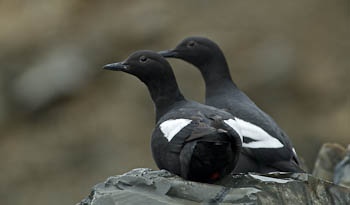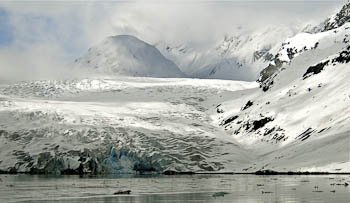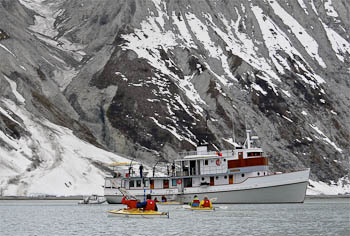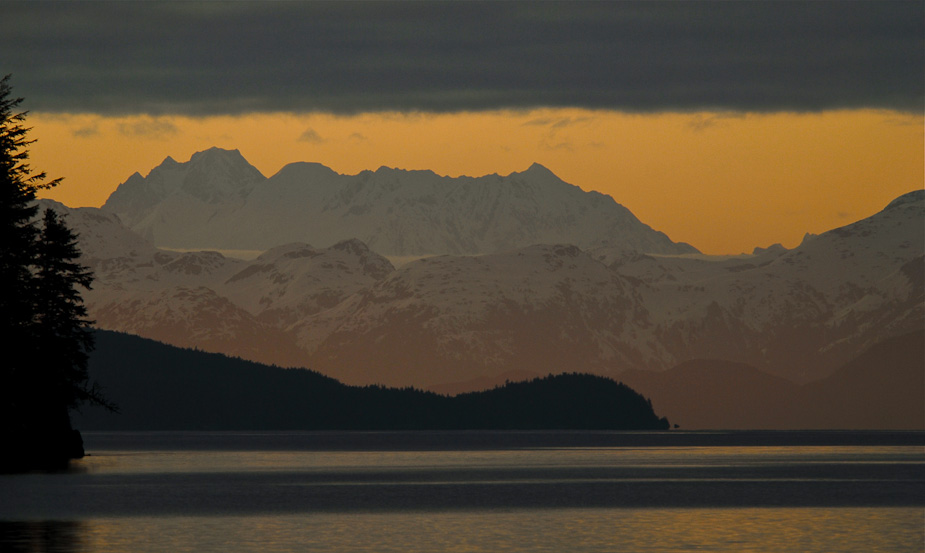I. CONSERVATION IN FOCUS:
ALASKA'S GLACIER BAY NATIONAL PARK
May 7-19, 2011
(13 Days/12 Nights)
Bob Rozinski & Wendy Shattil, Kimber Owen, Marilyn Hailbronner,
and the M/V Sea Wolf Crew
 Imagine Glacier Bay as John Muir saw it in 1899, as a member of the legendary Harriman Expedition—without the cruise ships, the guidebooks, and interpretive signs that define the modern visitor's experience. Glacier Bay is a deepwater fjord system with two arms, Muir Inlet and the West Arm, each more than 65 miles long. Traveling aboard the M/V Sea Wolf, a 97-foot vintage wooden boat, we'll have the chance to see this spectacular glacier-and-fjord landscape in much the same way that Harriman's scientists did. We'll trace the evidence of climatic change left behind by the advance and retreat of these immense glaciers—just as Muir did—and ponder the impacts and changes that loom on the horizon. Unlike the big cruise ships, Sea Wolf is trim enough to explore the narrowest of fjords and shallow coastal waters. She carries twelve passengers and a crew of five in superb comfort—the perfect size for a voyage such as ours. Best of all, Sea Wolf carries a full complement of sea kayaks and a motorized inflatable to enable exploration both far and wide. For those who take paddle in hand, the use of sea kayaks allows a more intimate, seal's eye view of the tidewater glaciers, inlets, islets, and estuary streams that make this coastal wilderness one of North America's most biologically diverse areas. Imagine Glacier Bay as John Muir saw it in 1899, as a member of the legendary Harriman Expedition—without the cruise ships, the guidebooks, and interpretive signs that define the modern visitor's experience. Glacier Bay is a deepwater fjord system with two arms, Muir Inlet and the West Arm, each more than 65 miles long. Traveling aboard the M/V Sea Wolf, a 97-foot vintage wooden boat, we'll have the chance to see this spectacular glacier-and-fjord landscape in much the same way that Harriman's scientists did. We'll trace the evidence of climatic change left behind by the advance and retreat of these immense glaciers—just as Muir did—and ponder the impacts and changes that loom on the horizon. Unlike the big cruise ships, Sea Wolf is trim enough to explore the narrowest of fjords and shallow coastal waters. She carries twelve passengers and a crew of five in superb comfort—the perfect size for a voyage such as ours. Best of all, Sea Wolf carries a full complement of sea kayaks and a motorized inflatable to enable exploration both far and wide. For those who take paddle in hand, the use of sea kayaks allows a more intimate, seal's eye view of the tidewater glaciers, inlets, islets, and estuary streams that make this coastal wilderness one of North America's most biologically diverse areas.
 May is a magical time to be in Glacier Bay, largely because the weather is at its best and we have these spectacular fjords to ourselves—just the bears, the first returning whales, and the thousands of migrating shore- and seabirds traveling the Pacific Flyway. Few people know this ice-bound wilderness as well as the Sea Wolf's owner, Kimber Owen. Against a backdrop of some of the most magnificent mountains on earth, rivers of glacial ice tumble into the sea and aquamarine-colored icebergs drift by on the tides. Responding to the boom and crash of ice at the glacier front, kittiwakes and Arctic terns swirl over the churning, welling waters in search of food. Western sandpipers and other shorebirds skitter along the shorelines, poking their bills into the food-rich mud and gravels of the intertidal zone. Sea ducks and huge rafts of harlequin ducks forage in quiet bays before making the final push to their breeding areas. Both brown and black bears, recently emerged from their hibernation dens, can be seen bending down the branches of black cottonwoods to feed on the sweetly resinous leaf buds, grazing on swards of lush sedges, or scraping succulent barnacles and mussels from rocks along the intertidal zone. For the wildlife of Glacier Bay and the outer islands, this is truly a time of plenty.
May is a magical time to be in Glacier Bay, largely because the weather is at its best and we have these spectacular fjords to ourselves—just the bears, the first returning whales, and the thousands of migrating shore- and seabirds traveling the Pacific Flyway. Few people know this ice-bound wilderness as well as the Sea Wolf's owner, Kimber Owen. Against a backdrop of some of the most magnificent mountains on earth, rivers of glacial ice tumble into the sea and aquamarine-colored icebergs drift by on the tides. Responding to the boom and crash of ice at the glacier front, kittiwakes and Arctic terns swirl over the churning, welling waters in search of food. Western sandpipers and other shorebirds skitter along the shorelines, poking their bills into the food-rich mud and gravels of the intertidal zone. Sea ducks and huge rafts of harlequin ducks forage in quiet bays before making the final push to their breeding areas. Both brown and black bears, recently emerged from their hibernation dens, can be seen bending down the branches of black cottonwoods to feed on the sweetly resinous leaf buds, grazing on swards of lush sedges, or scraping succulent barnacles and mussels from rocks along the intertidal zone. For the wildlife of Glacier Bay and the outer islands, this is truly a time of plenty.
 With all of Glacier Bay as our classroom, the year's first Conservation in Focus workshop, embodies the true spirit of an expeditionary voyage. Photography is a powerful tool for building a conservation constituency—whether you are interested in projects close to home or in the most remote corners of our changing world. Wendy Shattil and Bob Rozinski, members of the International League of Conservation Photographers, are recognized worldwide for their evocative images and for their compelling portrayals of at-risk ecosystems. But long before the camera became a standard piece of field equipment, expedition naturalists kept field journals in which to record their discoveries. Cloud Ridge's artist, Marilyn Hailbronner, follows that tradition, sharing her techniques for using drawing and photography to enhance your natural history observations. With all of Glacier Bay as our classroom, the year's first Conservation in Focus workshop, embodies the true spirit of an expeditionary voyage. Photography is a powerful tool for building a conservation constituency—whether you are interested in projects close to home or in the most remote corners of our changing world. Wendy Shattil and Bob Rozinski, members of the International League of Conservation Photographers, are recognized worldwide for their evocative images and for their compelling portrayals of at-risk ecosystems. But long before the camera became a standard piece of field equipment, expedition naturalists kept field journals in which to record their discoveries. Cloud Ridge's artist, Marilyn Hailbronner, follows that tradition, sharing her techniques for using drawing and photography to enhance your natural history observations.
Capturing the attention of your viewer requires a thorough understanding of your subject—as well as a strong sense of photographic integrity and ecological stewardship. This workshop is designed to refine your photographic skills and to help you make a difference with your images. We'll create a photo book that truly conveys the magic of "place." Our hope is that this voyage of discovery will provide inspiration for other conservation projects.
Price: $4,995 (includes a $500 deposit)
Group Size: 12
Trip Rating: 2-3
Price Includes: 10 nights/10 days aboard the M/V Sea Wolf, all meals and beverages aboard, 2 nights lodging in Juneau (May 7 & 18), two group dinners ashore, the services of a five-person crew and three naturalist leaders, roundtrip Air Excursions charter flight to Gustavus from Juneau (including a special scenic flight), all boat and hotel transfers, full sea kayak outfitting and instruction, gratuities to the Sea Wolf's crew, and all applicable state and local taxes. Does not include roundtrip airfare to Juneau, Alaska from your point of departure or meals other than those listed.
Need more information? Visit Sea Wolf Adventures online at www.seawolfadventures.net for pictures of the M/V Sea Wolf, her cabins, interior amenities, accessibility & crew biographies. |
